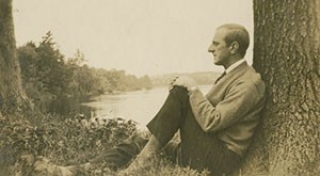Born 1877, Lewiston, Maine
Died 1943, Ellsworth, Maine
Hartley lived a peripatetic life as he restlessly traveled throughout the US and Europe in search of modernist innovation and artistic discovery. From Maine, he traveled to Cleveland, Ohio, to begin his artistic training, then moved to New York City in 1899 to study with American impressionist William Merritt Chase and at the National Academy of Design. In New York he met photographer Alfred Stieglitz, who gave the painter his first solo exhibition at the 291 gallery in 1909. Shortly thereafter, Hartley traveled to Europe, where he spent three years working in modernist enclaves in Paris, London, Munich, and Berlin. His time in Germany was noteworthy, as he experimented with modes of abstraction while exhibiting alongside members of Der Blaue Reiter, including Wassily Kandinsky, Franz Marc, and Gabriele Münter. Embracing this collective’s interest in ethnography, non-Western art, and forms of folk art, Hartley began to incorporate Native American motifs into his paintings and experimented with Bavarian glass painting (hinterglasmalerie), a technique he used in Vase of Flowers (1916).
Returning to the States in 1917, Hartley developed his interest in Native American culture along with North and South American folk art to create a truly American modernist tradition. In New Mexico from 1918 to 1919, he painted the Southwestern desert in a series of landscape studies. The Catholic-inspired visual traditions of Hispanic American cultures were of particular interest to Hartley. He began producing his own retablos, a traditional type of Hispanic devotional painting. In 1935, after a decade of travel in North America and Europe, Hartley settled in a fishing village in Nova Scotia, where he boarded with Francis and Martha Mason and their children Alty, Donny, and Alice. He developed a profound connection with the family and was devastated when Alty, Donny, and their nephew drowned while fishing during a storm. In the wake of the tragedy, Hartley created a series of paintings depicting the Mason family through the language of Christian iconography. Intended to be housed in their own commemorative chapel, these symbolically rich images are constructed in a flattened and self-consciously naïve aesthetic.
Nicholas Miller
Cassidy, Donna M. Marsden Hartley: Race, Region, and Nation. Hanover, NH: University Press of New England, 2005.
Griffey, Randall R. “Marsden Hartley’s Lincoln Portraits.” American Art 15, no. 2 (Summer 2001): 34–51.
